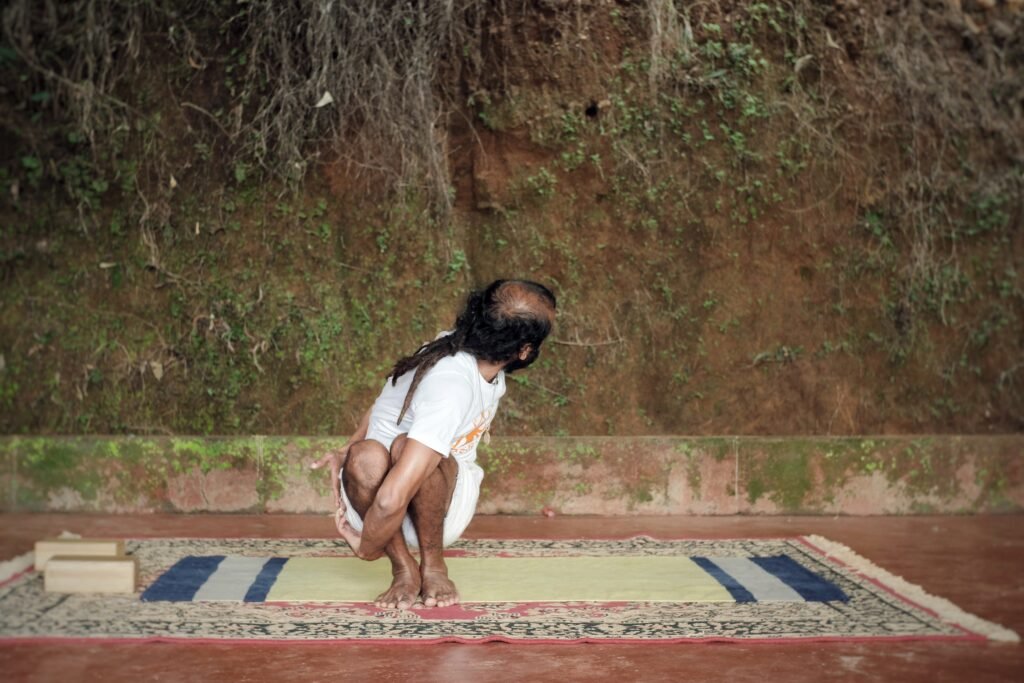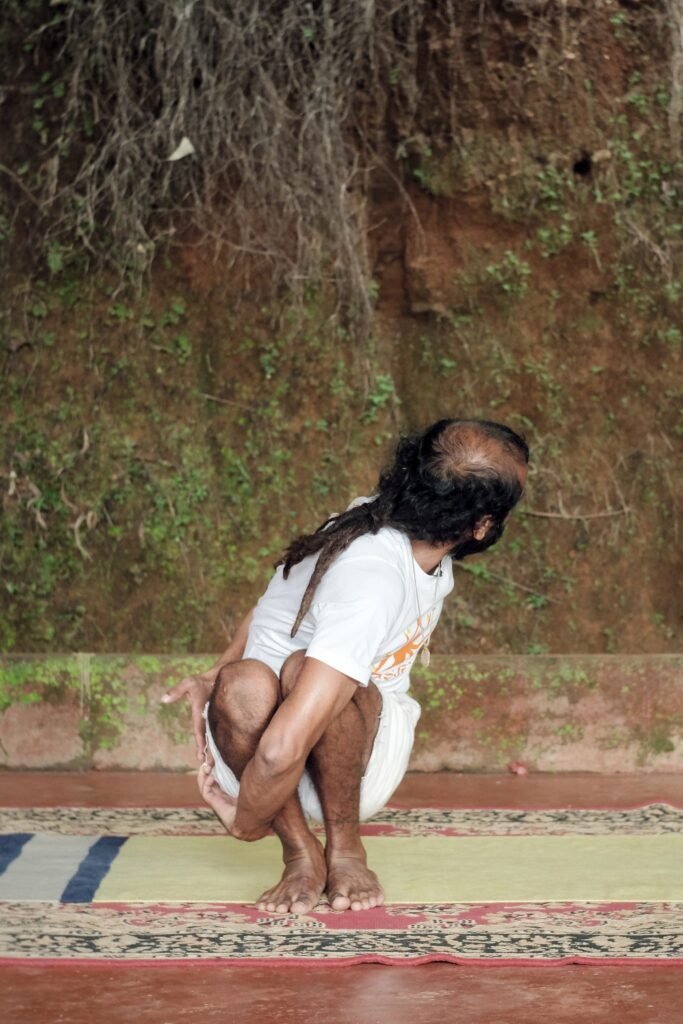
The Pasasana (Noose Pose) is a twisting seated bound pose where the arms are wrapped around the lower limbs like a noose or chord.
The position resembles a noose, which is nothing more than the loop at the end of a rope under a running knot that gets tighter as it is pulled when the arms are wrapped around the folded knees.
The Sanskrit name also implies the same thing because “Asana” means “Pose” and “Pasa” means “Knot” or “Loop”.
Like the Twisted Toestand Squat, the twisting action uses the entire back, chest, and abdomen to move the torso completely to one side with the addition of the hands encircling the waist and knees in a bind.
This bound spinal twisting pose is more complicated than some standing spinal twisting poses like Parivrtta Baddha Trikonasana (Revolved Bound Triangle Pose) or Baddha Parivrtta Parsvakonasana (Bound Revolved Side Angle Pose) because there is less room for the chest and abdomen to twist and less range of motion in the arms, shoulders, and hips.
The front torso muscles are contracted, making it difficult to breathe, bind, or hold.
The most crucial element of this practice is to use the breath most effectively, taking the practice in a step-by-step transition. It can be incorporated into the yoga sequence as the binding action helps to open the shoulders and for the core muscles (as the abdominal muscles are squeezed to create space for the back muscles to twist).
As a result, practicing the pose while holding the props will gradually get your body, mind, and breath ready for the full Noose Pose.
STEPS FOR NOOSE POSE:
- Take a tadasana pose.
- Bring your knees fully bent and squat down.
- Make sure to sit completely on your feet and keep your heels planted.
- Kneel with a slight leftward swing.
- As you exhale, twist the body to right, bringing your left shoulder to the outside of your right knee.
- Keep your right hand on the floor while reaching your left outer thigh with your left arm wrapped around both shins.
- Breathe deeply and extend your right arm, lifting the right shoulder to grab the left wrist.
- Continue to look up as you lift your chin toward your shoulder.
- Breathe and hold the position for 30 seconds.
- Release the twist as it returns to the center while exhaling.
- Continue on the left side.
- Sit back and unwind while releasing your hands.

Pasasana Advantages:
Lengthens, Strengthens, and Stretches
Noose Pose practice puts pressure on several joints, including the ankles (which support the weight of the body), knees (due to the squeezing action), hips (due to internal rotation and hip joint flexion), shoulders (due to the arm binding action), and wrists (with them being in a tight lock).
These joints become more stable with time and the involvement of all the muscles used during the twist.
The triceps and biceps are engaged to lengthen the arms, the rib cage and intercostal muscles (breathing muscles) open to support the shoulders and upper back, the core and pelvis contract and squeeze to support the lower back, and the leg muscles squeeze to support the hips and keep them strong and stable.
As a result, all the joints and muscles mentioned above lengthen and stretch together; over time, they develop stability and strength.
Flexibility and range of motion:
With continued practice and longer holds in the pose, the Noose Pose gradually improves the dynamic range of movements of the involved joints and muscles. Students may be prepared for the next level or advanced yoga poses, which include twists and a bind, such as Sage Marichi Pose H (Marichyasana H) or Revolved Bird of Paradise Pose, with increased flexibility (Parivrtta Svarga Dvijasana).
Breath, chest, and diaphragm:
The twisting motion of the pose enables the body to inhale deeply, which clears the energy channel. Of course, the twisting pose significantly impacts heart opening due to the diaphragm’s expansion.
The intercostal muscles are mostly contracted during this twist. The lengthening, stretching, contracting as well as twisting action of the upper back and chest changes the functioning of the intercostal muscles.
Awareness and Focus (Concentration):
The first step to this pose is to learn to balance the body while in a twist in Twisted Toestand Squat. The next stage is to remain in this twist for some time without losing balance. The final step to Noose Pose requires the chest and shoulders opening to create the twist and take the arms in a bind. The progression happens just not with the muscles or joints but by coordinating all the movements with the breath. Knowing where to inhale, hold, and exhale, can help to get the best from the pose. This awareness can help prepare advanced poses that involve the squeezing action of the chest and ribs.
Alignment and Posture:
Ensure to put the feet together, lengthening the spine and torso before squatting, raising the arm to lengthen the spine before twisting, lengthening the arm around the knees to take it far back, making sure the knees are together when in the bind, making sure the heels are grounded to provide space for the hips to remain stable, and keeping the neck active to take the final posture. Together, each of these movements is performed while maintaining hip and knee alignment.
The final pose will feel beautiful and look perfect when the alignment is exact, which will also gradually aid improve the body’s overall posture.
Energizing, De-stressing, Relaxing:
The basic goal of the Noose Pose, which is a part of the Nadi Shodhana Intermediate Series, is to open the energy channel that enables the prana to move through the body smoothly and actively, getting to every cell.
Each cell, muscle, tissue, etc. is kept active and fresh when the active prana flow (the flow of oxygenated blood) occurs through the body, eliminating any sluggishness.
This further aids in calming the mind, emptying the mind of distractions, and assisting in decision-making in daily life.
Intense twisting positions like Noose Pose can help you obtain energy, which is more than just feeling good. Energy is about feeling revitalised and ready to take on the world.
Stimulation and Organs:
The squeezing action on the chest, rib cage, and abdomen during the pose activate the solar plexus chakra, popularly known to balance the body’s fire element. Twisting with the side-stretch stimulates blood circulation and releases tension in the abdomen’s muscles, creating an intra-abdominal compression to supply a fresh oxygen-rich blood to the abdominal organs. This helps improve digestion, and people with issues related to urinary incontinence benefit if the same is practiced using the appropriate props.
Balance and Emotions:
Yoga peak posture sequences can include Noose Pose, and the ascent to this pose should be calm, slow, and deep. The posture will first cause a great deal of discomfort in the physical body, the breath, and even the energy (prana), which will lead to an imbalance in the body-mind-breath. When the body-mind-breath is in rhythm, one can shift from this imbalance to balance. When this stage arrives, the mind and thoughts (emotions) reach a new degree of satisfaction and mental capacity, bringing a state of bliss (anandha). When both within and outside of the human body are in balance, this anadha state manifests. Therefore, advanced positions like these are done to achieve this joyful condition.
Circulation and Systems:
The posture causes the solar plexus chakra, which is renowned for balancing the body’s fire element, to contract at the chest, rib cage, and abdomen.
Twisting with the side-stretch increases blood flow and relieves muscle tension in the belly, resulting in an intra-abdominal compression that supplies the abdominal organs with a new supply of oxygen-rich blood.
If the same is practised with the appropriate props, some kids with challenges related to urinary incontinence may also benefit from this because it improves the digestive system.
(Noose Pose) Pasasana Contraindications:
- Injury and Surgery: As Noose Pose pressurizes the lower back, hips, neck, and abdominal organs, any injury to these muscles and joints are contraindicated. Also, people, even with an old injury or surgery related to any part of the body should let the yoga teachers know.
- Ailment and Physical Strength: Since Noose Pose is hard on the body (joints and muscles), people with issues related to spondylitis, IBD (Inflammatory Bowel Disease), arthritis, diastasis recti, blood pressure, or weak immune system, are all contraindicated.
- Others: Kids too should be refrained from this practice; although they may have supple bodies, their spines cannot take this kind of twist.
